What is B2B content marketing? Learn the top B2B content marketing strategies that you need to start using today.
B2B content marketing strategies to help you generate new customers, engage clients, and boost sales.
At this very second, thousands of people are looking for content just like yours. So you need to build bridges to help them find you.
Content marketing is one great way to do that.
But here is a challenge: the competition is getting fiercer day by day.
Why? It is because 91% of B2B marketers are using content marketing in their overall strategy.
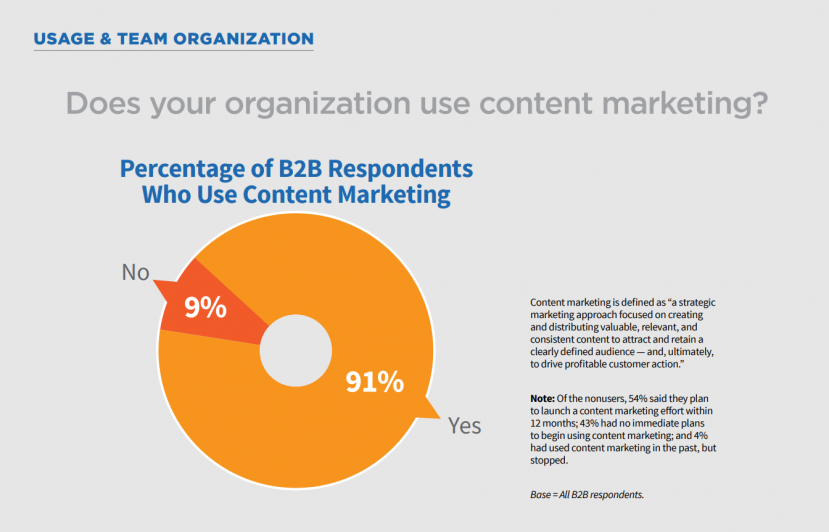
That’s why you need the right content marketing strategies so that you can bring more visibility, engagement, and conversions.
What is B2B Content Marketing?
Here is the definition of content marketing by The Content Marketing Institute:
Content marketing is a strategic marketing approach focused on creating and distributing valuable, relevant, and consistent content to attract and retain a clearly-defined audience — and, ultimately, to drive profitable customer action.
As its name suggests, business to business, the audience for B2B content marketing would be for businesses.
In other words,
B2B content marketing is a marketing technique of creating and distributing content consumed by other businesses.
Even though B2B content marketing concentrates on businesses, people make decisions.
Keep that in mind as we look at the top B2B content marketing strategies you can implement right away.
B2B Content Marketing Strategies
Whether you are a B2B content marketer, running a start-up, or an established business, employing the right B2B content marketing can help your business appeal to other businesses.
Here are some promising B2B content marketing strategies to move you a step ahead of your competitors.
Know What is Your Goals
Take a moment to think about why you want to produce content and develop a content marketing plan?
You must know your goals before you begin. As the saying goes:
Begin with the end in mind.
Once you have your BIG WHY in place, you will have an easier time determining your content marketing strategy.
Here are some common goals:
- Creating brand awareness as you can reach a relatively broad audience.
- Improving customer engagement by sharing and connecting with your audience.
- Becoming the thought leader as you can position your brand as the authority within your niche.
- Creating brand loyalty as your content can help solve problems and answer your clients’ questions.
- Getting more traffic to your website so that you can achieve other goals.
- Generating high-quality leads, which will contribute to your revenue goals.
- Improving your revenue as a result of your content marketing strategy.
It will be tempting to take up all goals mentioned above because it’s kind of overlapping. Also, it would be impossible to choose just one. So I would recommend you to choose one main goal with a few additional sub-goals.
For example, your main goal could be to improve your revenue. Your sub-goals could be getting more traffic and generating leads. Then, you may build your content marketing strategy based on those goals.
To give you some insight, the three most-cited content marketing goals achieved in the last 12 months were the following: create brand awareness (81%), educate the audience (73%), and build credibility/ trust (68%).
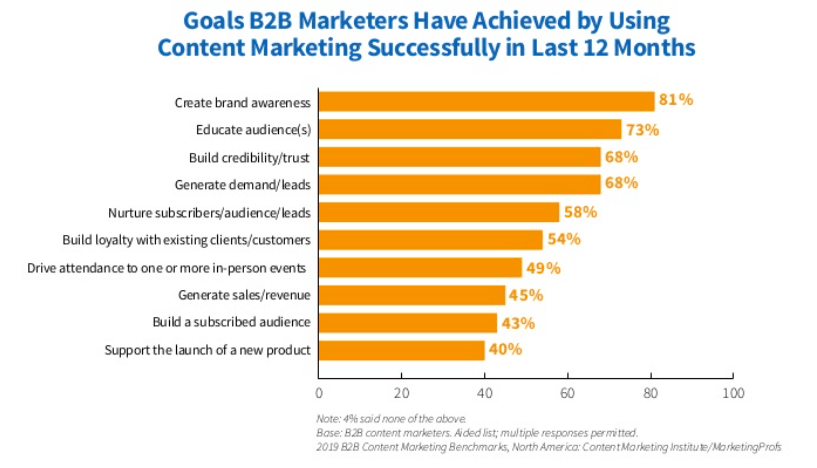
And surprisingly, fewer B2B marketers say their content marketing effort is performing against goals like building subscribed audiences (58%), generating sales/ revenue (45%), and building loyalty with existing clients/customers (54%).
Nevertheless, stick to what works for you. Identify your ultimate goals and works toward achieving them.
Understand Your Target Audience
We live in an age where customers expect a personalized experience. Therefore, it is crucial to create content tailored to different sales funnels, but first, you need to know who your target audience is.
That said, only 54% of B2B marketers create content that’s more audience-centric than brand-centric. In other words, nearly half of B2B businesses are neglecting their audience’s needs and interests.

Depending on how you look at the stats, it is an excellent opportunity to start shifting your B2B marketing strategy.
Start creating your buyer personas if you didn’t have one. It will help you in visualizing your audience and guiding you in making a strategic decision.
Use a free tool like Google Analytics to understand your audience. Dig around the Audience category to gather useful information such as their location, gender, age, and interests.

You can also discover your buyer persona’s driving force by checking the traffic sources and website interactions.
Other than Google Analytics, you may also check out your social media analytics as it has a wealth of data too.
Here are some of the information you want to include in your buyer persona:
- Name
- Title
- Industry
- Age
- Goals
- Challenges
- Information sources
- Content preferences
The set of information you choose should be full of details and useful for your content marketing strategy.
You need to bear in mind that buyer personas are not set in stone. They could change over time in terms of challenges, content preferences, and so on.
So, do not limit yourself to just looking at the analytics. Interview your clients or send them surveys. It will keep your buyer personas up-to-date and relevant to your business.
Map Content based on the Buyer Journey
Brent Adamson from Gartner once said:
As hard as it has become to sell in today’s world, it has become that much more difficult to buy. The single biggest challenge of selling today is not selling; it is actually our customers’ struggle to buy.
You need to understand the buyer’s journey so you can give value and answers at every stage. If done right, you may help move them along the journey, from awareness to deciding to buy from you.
In contrast to “business-to-consumer” (B2C), B2B buyers are often more than a single person because you are selling to an entire group of decision-makers.
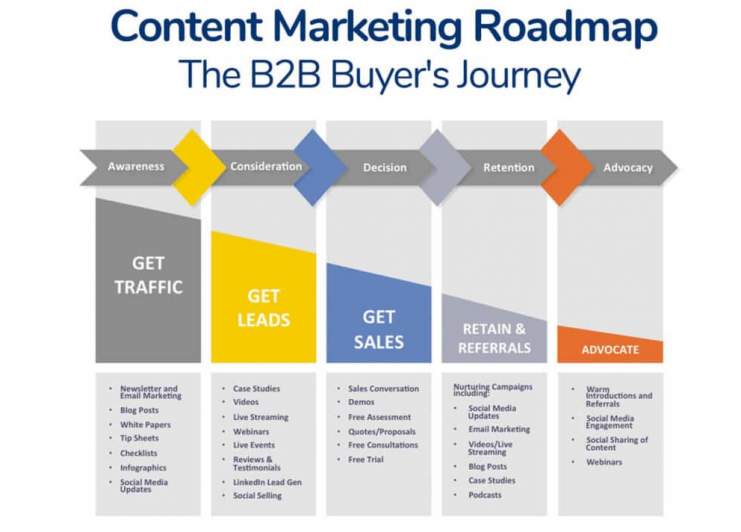
The buyer’s journey generally includes these three stages:
Awareness: your potential buyer knows that there is a problem or challenge they need to solve, but they may not be aware of your business’s existence.
What should you do?
Your marketing strategy should be focusing on creating awareness of your product or service. This can be done by helping your potential buyers understand what you do and how you can help them. This is also an excellent time to build buyer trust.
Consideration: your potential buyer is now considering whether to buy from you or the other competitors. They will search for more information for a better comparative analysis.
What should you do?
Provide information that allows them to conduct their more in-depth research and decide whether your product or service is a good fit for them. This is your opportunity to showcase how your offering can meet or solve their needs.
Decision: your potential buyer will make the decision and purchase from the chosen supplier.
What should you do?
Nothing speaks louder than your real customers’ experience. Show what others have achieved by choosing you, how positive their experience has been, and evidence of being the best fit.
Mapping your content based on the buyer journey is an effective B2B content marketing strategy because it allows you to create unique content for each buying process stage.
Next, we will get into the different types of content marketing you can create for different stages.
Create the Right Type of Content
According to a report from Content Marketing Institute and MarketingProfs, the top 3 types of B2B content marketers use are social media content, blog posts or short articles, and email newsletters.
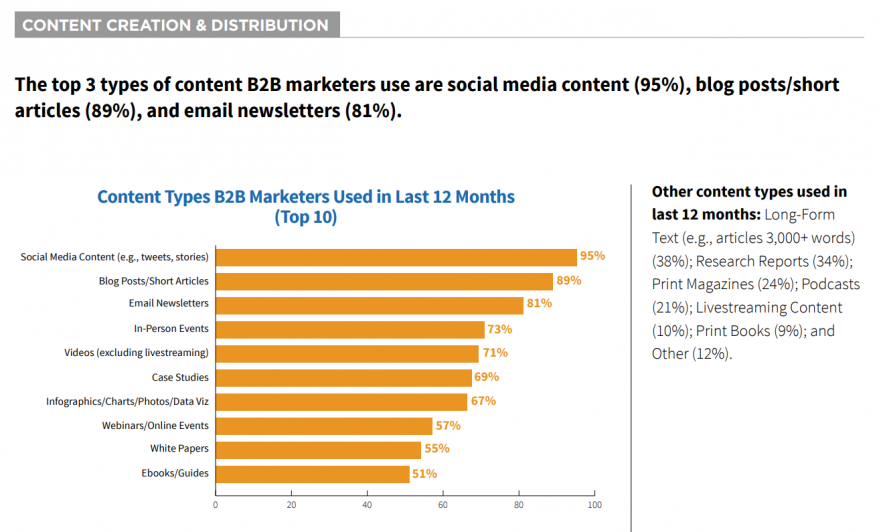
But that doesn’t mean you must use the same types of content for your business. You need to assess the kind of content relevant to your buyer persona in different buyer stages.
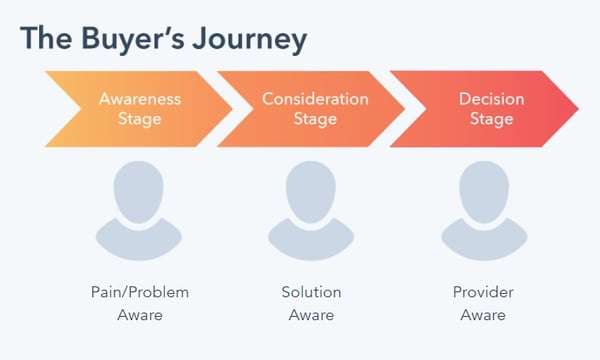
Your buyer persona will determine the effectiveness of your content marketing strategy.
For example, if your buyer persona is an accountant manager that prefers reading long content, you may want to provide in-depth information throughout the buying stages.
Do you know that every search you made in the search engine represents an intent?
Without knowing the intent, you lack a strategy.
Have a look at how you can use Keyword Intelligence to check the keyword intent.
The keyword intent includes informational, navigational, and transactional.
The keyword ‘content marketing’ has an informational intent, which means the searchers are in the awareness stages.
That data may help you create the type of content that is suitable for the awareness stage. For example, ‘why do you need content marketing?’ and ‘top content marketing examples’.

Scroll down and you’ll be able to identify each keyword intent so that you can understand your target audience better.
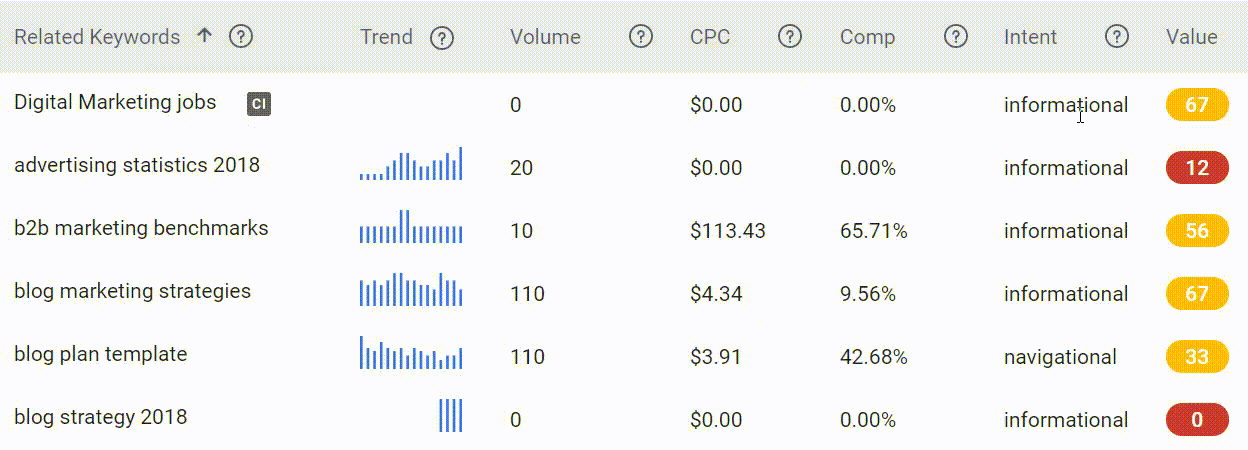
That is a great help because it eliminates assumptions and guesswork to identify the searchers’ intent.
Increase Engagement by Creating Quality Content
There are approximately 4,000 to 10,000 marketing messages that are seen every day.
With the tsunami of ads, we can’t help but click the ‘Skip Ads’ buttons.
Your brand could quickly lose in those marketing messages, so you need to be distinctive and memorable than the rest.
How?
Tell a story.
We are curious by nature. That explains why content marketing and storytelling are a perfect match.
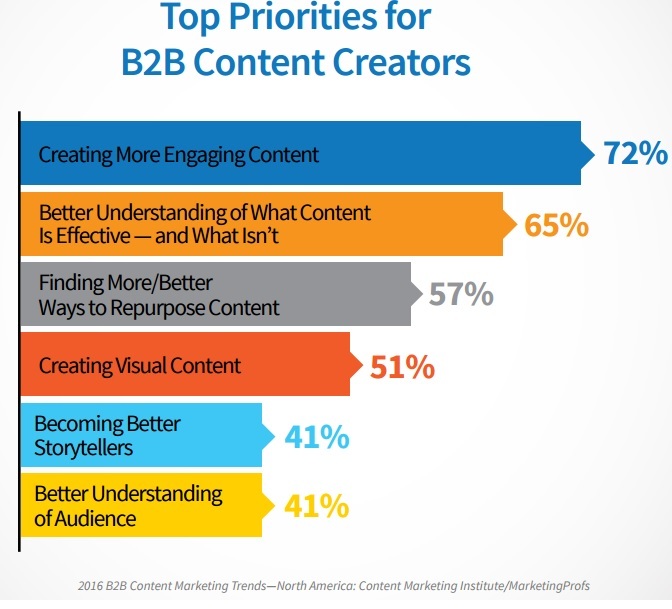
41% of B2B content creators voted “becoming better storytellers” as one of their top priorities.
Using stories in your B2B content will give a booster in your sales because the buying decisions are 80% emotional and 20% logical.
Here are a few ways you can use to tell your brand’s story:
Seeing is believing – your potential buyers need to see your offering before they believe it. You may use video or pictures to convey your story.
Employee-curated stories – showcasing your employees’ stories creates transparency and authenticity in your business.
Here is one content marketing strategy example in action:
Microsoft’s Story Labs show in-depth profiles of their employees across all departments.
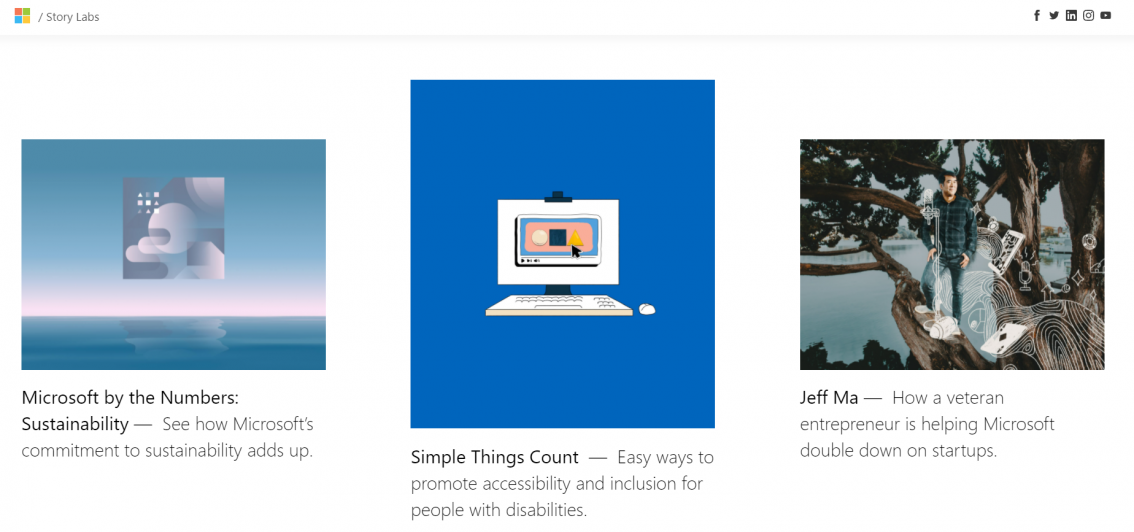
Let customers tell their stories – ask your customers about their success with your product or service. It feels authentic and real when other customers tell their stories.
Shopify Stories show inspiring stories of how Shopify helps business owners to sell online.
A good story helps customers know your brand and what it stands for. It also connects the gap between your business and your potential customers.
Use Social Validation
Self-propagating strategies are no longer effective. People like seeking information about products and services directly from other people like them.
That’s precisely where social validation comes into the big picture.
Social validation is, quite simply, the behavior where people tend to copy what others do. When you use them correctly, it will increase your sales.
Imagine when a new prospect comes into your website, they will look around and wonder why they should purchase from you.
You can use brand and product approval on social and customer review sites to aid in their decisions.
Here are some ways you can use social proof to achieve them:
- Testimonials – there is research that stated 92% of people would trust recommendations from a peer. That’s why this is the most commonly used social proof. You may display your customer testimonials on your website or create a special page dedicated to listing them.
- Real-time stats – you can show real-time stats such as purchases, signups, views, or anything you want on your site.
- Case studies – because of its credibility, 13% of marketers name case studies as one of the primary forms of media used within their content strategy. Identify your customer problem and showcase how your product and service can help to solve it.
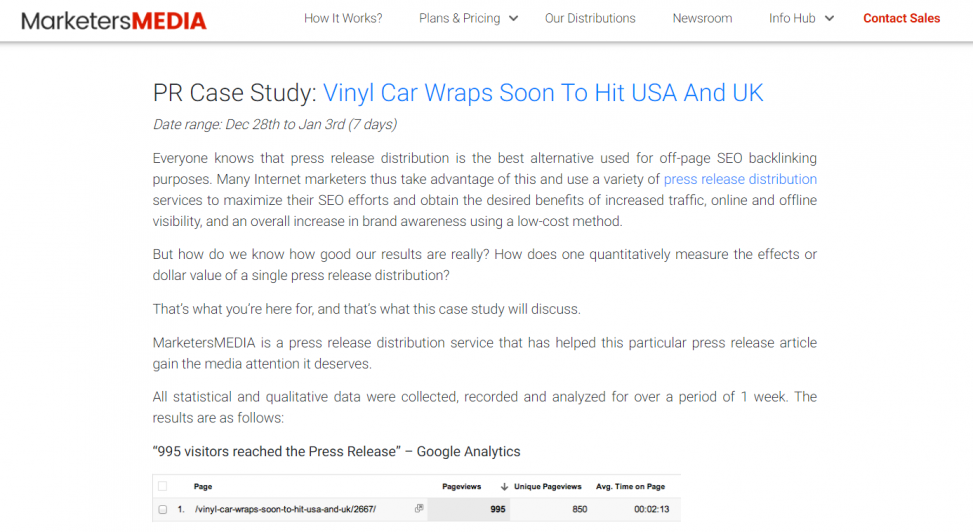
- Celebrity endorsements – it is becoming more effective because people feel more obligated to purchase from someone they may relate to or idolize. You can benefit from the celebrity’s fame and status to get your product or service to appeal to a new and broader audience.
Perform SEO Content Audit For Your Blog
If your content doesn’t have what it takes to rank organically, then your content marketing efforts are all for nothing.
So do you know how well your blog content is performing at this time?
Kudos, if the answer is YES.
If it’s a NO, fret not; you can quickly check your content performance using Content Intelligence.
Enter your content’s URL with your target keyword in the AI-powered content checker tool. It will check your overall content to see how well it’s performing than the top 10 rankings.
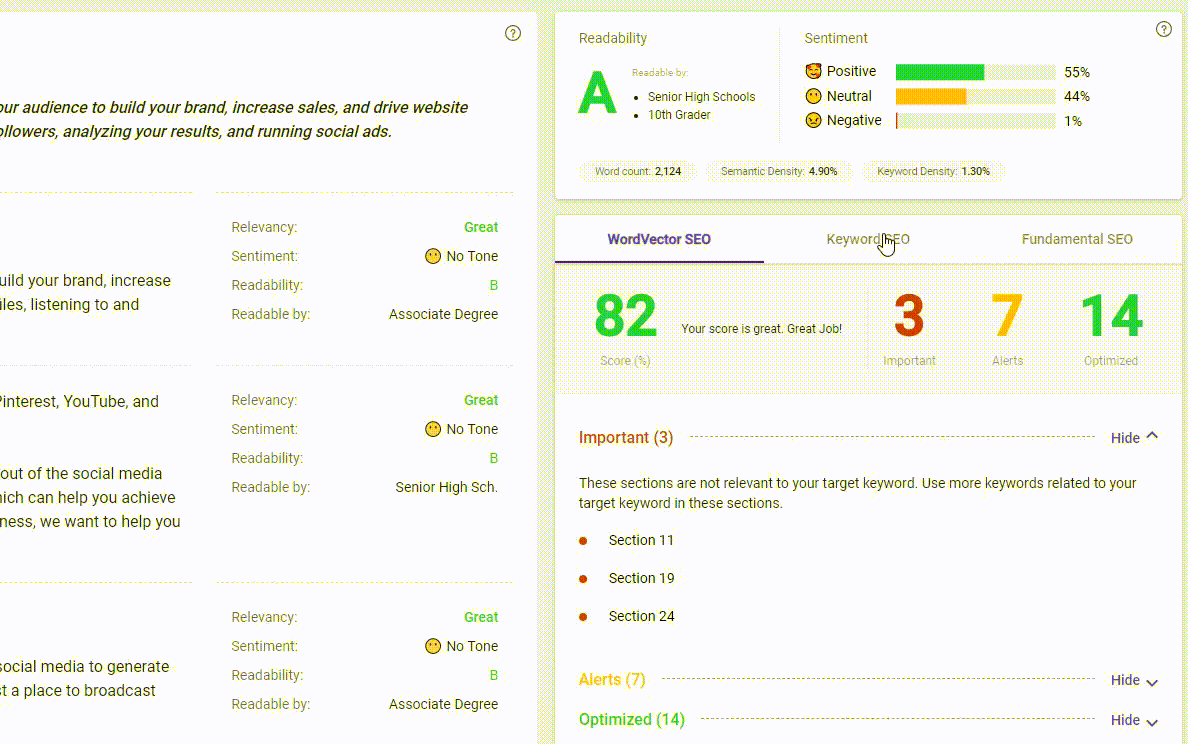
Here are some of the features this awesome tool covers:
- WordVector optimization – get to know how relevant your content is against the top 10 rankings and increase the relevancy.
- On-page optimization – see your on-page SEO score and get easy-to-follow suggestions to improve your online presence.
- Keyword optimization – check your target keyword score and get a list of actionable optimization suggestions to improve your keyword rankings.
- Advanced line-by-line analysis – discover each paragraph’s SEO value, sentiment value, and readability level.
Now, what if you have more than 100+ blog posts?
You must be thinking of giving up on doing content audits because that’s too much to do.
It doesn’t have to be that way…
Here is a helpful tip, focus on the 20% of posts that contribute to 80% of your website traffic.
How?
Get to know your top-ranking keywords using Rank Intelligence.
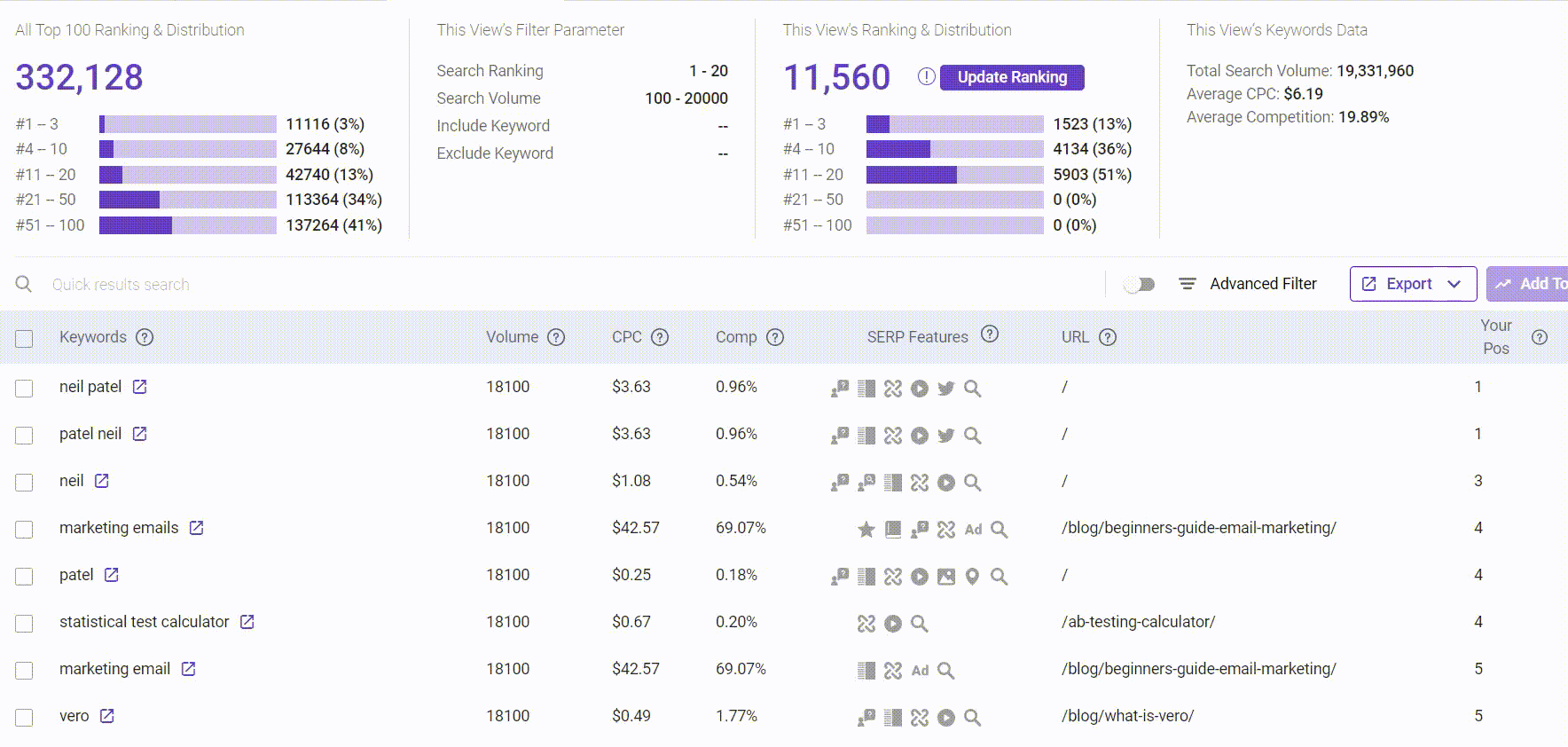
It shows you how many and what keywords you are ranking so you can find your top traffic driving keywords and see which keywords to optimize.
You will see each ranking keyword come with its essential insight that will help you discover your strengths and weaknesses.
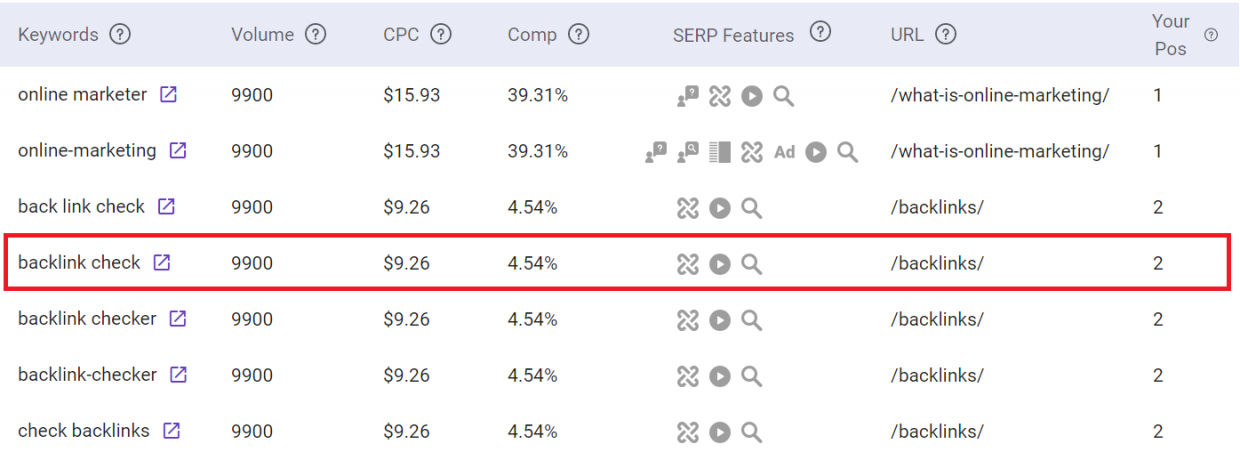
That way, you can focus your efforts strategically instead of auditing all 100+ content.
You may start optimizing the content ranking between the fifth to the tenth ranking position before optimizing those contents on page two. This is because it is easier to move sixth to first ranking position than 20th to first.
I have previously written an in-depth, step-by-step guide on SEO content audit, do check them out.
Monitor Metrics for Growth
Another essential aspect that should be at the top of your B2B content marketing strategies is monitoring growth metrics.
Content marketing is full of experiments – from testing which topics interest your audience to determining what content types work best for your business.
The truth is that you will try a lot of things, most of which may not work in your favor. While such experimentation is tiring, it is crucial in the long run. How you use the information from the experiments is what counts, and that’s why metrics are essential.
Here are the top metrics B2B marketers are using to measure their content performance:
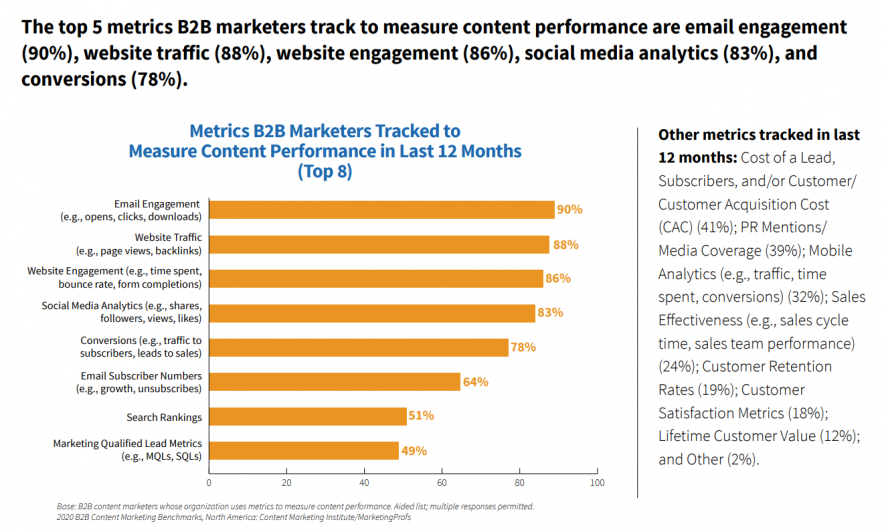
Put the right monitoring measures in place as you start your content marketing journey. Monitoring your failure or success is vital in B2B content marketing in that:
- It gives you lessons on what works and what doesn’t as far as your B2B content marketing strategies are concerned.
- It guides you into building a marketing strategy that’s based on real data in the industry.
Essentially, with the right metrics in place, you understand the approaches that did not work and build your next strategy around tactics that proved to work.
If you are doing a blog, you need to track and monitor your SEO performance. You may use Rank Tracking to achieve them.
Just enter your domain name, and it’ll help you keep track of your ranking keywords and pages.

From your dashboard, you’ll be able to see your website ranking progress, how many rankings are improving or dropping, and your ranking distribution.
If you have any specific keywords to track, you can add them manually.

If you are unsure which keywords to track, you can always check your ranking keywords in Rank Intelligence.
Adopt B2B Content Marketing Strategies to Grow Your Business
Staying on top of content marketing could take a lot of research and experimentation. But once you see the fruit of your labor, trust me, it will all be worth it.
Let me know which B2B content marketing strategies have and haven’t work for you in the comment below.




